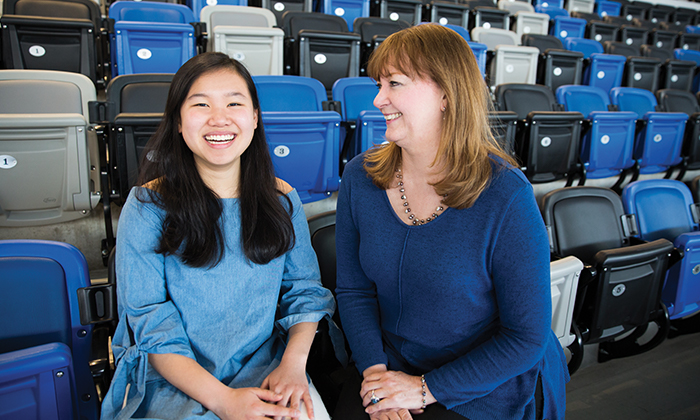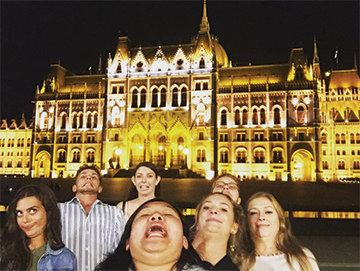
Bentley’s Clarissa Sawyer and Michelle Liu ’18 explore how humor — via Liu’s “chinning” selfies that have gone viral around the world — is challenging beauty standards on social media.
What inspired @chinventures on Instagram?
MICHELLE LIU: Chinning was actually born out of my insecurities from middle school. I was a little self-conscious about how I looked because of the pressures of society and my peers. Selfies were really popular at the time, so I embraced my quirky side with “chinning.” My friends thought it was really funny, so I just continued it all the way through college. I created the Instagram account while studying abroad in Vienna, Austria, during junior year, to combine my love of chinning and traveling.
How does humor help us deal with insecurity?
CLARISSA SAWYER: Humor is so important for relationships and self-esteem. Research shows that it relieves stress, elevates mood and makes you more resilient. And it’s a really powerful tool for managing conflict and reducing tension.
Stanford psychologists demonstrated that when you show people complicated pictures that might have something negative in them — car accidents, death, dental exams — asking them to create a joke before responding with their emotional reaction helps them reinterpret a situation or image that ordinarily might be perceived as negative. This explains the phenomenon of “gallows humor,” a way to reframe something negative.
How did chinning take on a life of its own?
ML: Mic published an article in October 2017 and I received a few hundred followers during the next few days. Then I got emails or direct messages on Instagram from sources such as BuzzFeed, INSIDER, Travel + Leisure, Self and Huffington Post. I also Skyped into the Morning Show in Australia, spoke on BBC Radio 5 live and traveled to New York for The Dr. Oz Show. In these two weeks I gained the majority of my 60,000 to 62,000 followers. About 80 percent are women.
What accounts for the response?
CS: Humans notice anomalies. “Chinfies” defy what we typically see in a selfie, which is an attempt to portray ourselves in a more self-enhancing way.
ML: I was shocked that it resonated with people. I didn’t realize there was this whole psychological component.
 What does psychology say about the impact of social media on behavior and self-esteem?
What does psychology say about the impact of social media on behavior and self-esteem?
CS: Feeling self-conscious is common for many young people, in particular girls. They’re socialized to compare themselves to other people to develop their identity. When they’re communicating their identity through social media images or text, and they get a lot of comments about their body, it can be harmful to self-esteem. By being comfortable enough to make fun of herself, Michelle is showing self-confidence and the positive side of social media by helping someone on the other side of the planet realize, “Oh my gosh, I’m OK the way I am.”
ML: A lot of people comment about how funny my photos are. But I also get messages telling me how @chinventures is inspiring and that it helped someone become less self-conscious about their chin or their looks. I never imagined that I would have that kind of impact.
Does chinning connect to any topics you explore in the classroom?
ML: In a marketing course, I did a contemporary issues project on influencer marketing to explore how influencers on social media affect consumers and general Instagram users, and whether influencers are more effective than traditional forms of advertising. It really got me thinking about the way that @chinventures is challenging and influencing beauty standards.
CS: I encourage students to connect the concepts I’m teaching to their own experiences. In my social psychology class, the very first assignment is related to self-concept. I ask students to come up with five unique characteristics of themselves for three different social situations: social media, a first date and a job interview. Students are surprised to discover how much each situation influences the characteristics they choose.
Is there a message you hope people get from @chinventures?
ML: Be free to do what you want without feeling judged or pressured to look or act a certain way. Try not to think too much about society’s standards. Instead, be yourself and love yourself. Do what you enjoy. Smile. Have fun.
About the Participants
Michelle Liu ’18 launched her @chinventures Instagram account in September 2016 with a goal of taking selfies less seriously by “making as many chins as possible!” When she isn’t posting for her international following, the Marketing major is polishing her leadership skills: Liu is an intern at PerkinElmer and served as a service–learning program manager and orientation leader at Bentley.
In the mid-1970s, a TIME magazine article on the “human potential movement” inspired Clarissa Sawyer to explore the field of psychology. (She was a high school senior.) Today, she holds a doctorate in education, serves as a lecturer in natural and applied sciences at Bentley, and teaches courses on gender psychology and social psychology.

